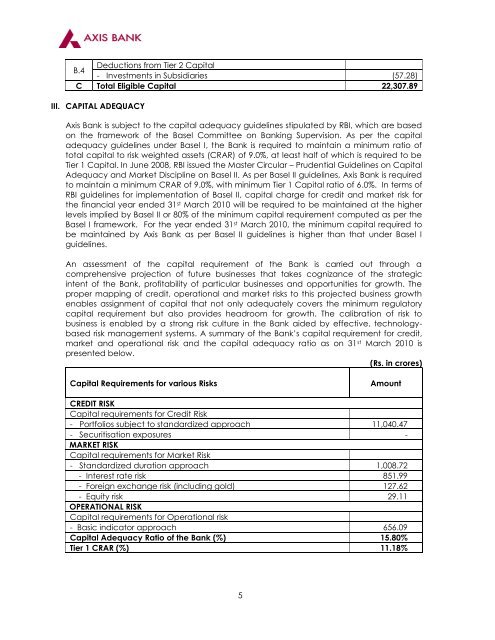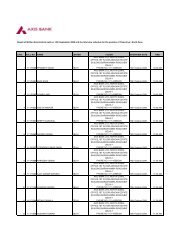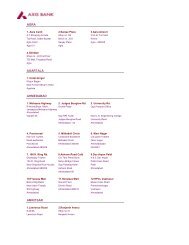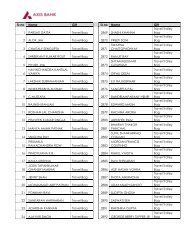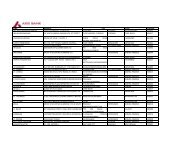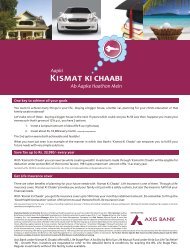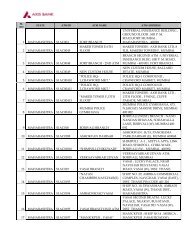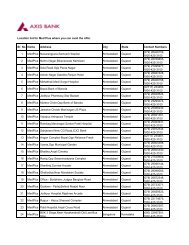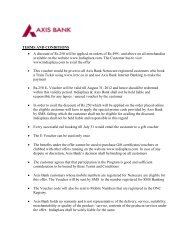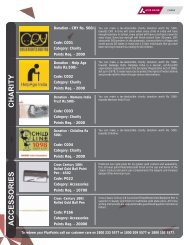Scope of Application
Scope of Application
Scope of Application
You also want an ePaper? Increase the reach of your titles
YUMPU automatically turns print PDFs into web optimized ePapers that Google loves.
B.4<br />
Deductions from Tier 2 Capital<br />
- Investments in Subsidiaries (57.28)<br />
C Total Eligible Capital 22,307.89<br />
III. CAPITAL ADEQUACY<br />
Axis Bank is subject to the capital adequacy guidelines stipulated by RBI, which are based<br />
on the framework <strong>of</strong> the Basel Committee on Banking Supervision. As per the capital<br />
adequacy guidelines under Basel I, the Bank is required to maintain a minimum ratio <strong>of</strong><br />
total capital to risk weighted assets (CRAR) <strong>of</strong> 9.0%, at least half <strong>of</strong> which is required to be<br />
Tier 1 Capital. In June 2008, RBI issued the Master Circular – Prudential Guidelines on Capital<br />
Adequacy and Market Discipline on Basel II. As per Basel II guidelines, Axis Bank is required<br />
to maintain a minimum CRAR <strong>of</strong> 9.0%, with minimum Tier 1 Capital ratio <strong>of</strong> 6.0%. In terms <strong>of</strong><br />
RBI guidelines for implementation <strong>of</strong> Basel II, capital charge for credit and market risk for<br />
the financial year ended 31 st March 2010 will be required to be maintained at the higher<br />
levels implied by Basel II or 80% <strong>of</strong> the minimum capital requirement computed as per the<br />
Basel I framework. For the year ended 31 st March 2010, the minimum capital required to<br />
be maintained by Axis Bank as per Basel II guidelines is higher than that under Basel I<br />
guidelines.<br />
An assessment <strong>of</strong> the capital requirement <strong>of</strong> the Bank is carried out through a<br />
comprehensive projection <strong>of</strong> future businesses that takes cognizance <strong>of</strong> the strategic<br />
intent <strong>of</strong> the Bank, pr<strong>of</strong>itability <strong>of</strong> particular businesses and opportunities for growth. The<br />
proper mapping <strong>of</strong> credit, operational and market risks to this projected business growth<br />
enables assignment <strong>of</strong> capital that not only adequately covers the minimum regulatory<br />
capital requirement but also provides headroom for growth. The calibration <strong>of</strong> risk to<br />
business is enabled by a strong risk culture in the Bank aided by effective, technologybased<br />
risk management systems. A summary <strong>of</strong> the Bank‟s capital requirement for credit,<br />
market and operational risk and the capital adequacy ratio as on 31 st March 2010 is<br />
presented below.<br />
(Rs. in crores)<br />
Capital Requirements for various Risks<br />
5<br />
Amount<br />
CREDIT RISK<br />
Capital requirements for Credit Risk<br />
- Portfolios subject to standardized approach 11,040.47<br />
- Securitisation exposures -<br />
MARKET RISK<br />
Capital requirements for Market Risk<br />
- Standardized duration approach 1,008.72<br />
- Interest rate risk 851.99<br />
- Foreign exchange risk (including gold) 127.62<br />
- Equity risk 29.11<br />
OPERATIONAL RISK<br />
Capital requirements for Operational risk<br />
- Basic indicator approach 656.09<br />
Capital Adequacy Ratio <strong>of</strong> the Bank (%) 15.80%<br />
Tier 1 CRAR (%) 11.18%


